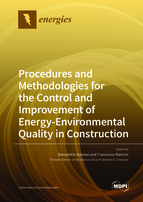Procedures and Methodologies for the Control and Improvement of Energy-Environmental Quality in Construction
A special issue of Energies (ISSN 1996-1073). This special issue belongs to the section "B: Energy and Environment".
Deadline for manuscript submissions: closed (30 November 2020) | Viewed by 43491
Special Issue Editors
Interests: building physics; building services engineering; building simulation; renewable energy technologies; indoor environmental quality; thermal and acoustic comfort; energy efficiency; zero energy buildings
Interests: building physics; building services engineering; building simulation; renewable energy technologies; indoor environmental quality; open data & energy analytics; energy efficiency; zero energy buildings; power-to-X solutions; buildings, district and national energy systems
Special Issues, Collections and Topics in MDPI journals
Special Issue Information
Dear Colleagues,
The energy and environmental performance of buildings is of primary interest, since the building sector is responsible for a large amount of energy consumption and related emissions. Building renovation to improve the above-mentioned performance as well as ensuring a better built environment is crucial.
For this purpose, “Procedures and Methodologies for the Control and Improvement of Energy-Environmental Quality in Construction” require reliability, robustness, and easy adoption at a building and an urban scale.
This Special Issue aims at providing the state-of-the-art on procedures and methodologies developed to improve energy and environmental performance through building renovation.
Building physics experts, building technology researchers, and urban environment scholars are warmly invited to contribute to this Special Issue by sharing their original works in the field.
Prof. Dr. Francesco Mancini
Dr. Benedetto Nastasi
Guest Editors
Manuscript Submission Information
Manuscripts should be submitted online at www.mdpi.com by registering and logging in to this website. Once you are registered, click here to go to the submission form. Manuscripts can be submitted until the deadline. All submissions that pass pre-check are peer-reviewed. Accepted papers will be published continuously in the journal (as soon as accepted) and will be listed together on the special issue website. Research articles, review articles as well as short communications are invited. For planned papers, a title and short abstract (about 100 words) can be sent to the Editorial Office for announcement on this website.
Submitted manuscripts should not have been published previously, nor be under consideration for publication elsewhere (except conference proceedings papers). All manuscripts are thoroughly refereed through a single-blind peer-review process. A guide for authors and other relevant information for submission of manuscripts is available on the Instructions for Authors page. Energies is an international peer-reviewed open access semimonthly journal published by MDPI.
Please visit the Instructions for Authors page before submitting a manuscript. The Article Processing Charge (APC) for publication in this open access journal is 2600 CHF (Swiss Francs). Submitted papers should be well formatted and use good English. Authors may use MDPI's English editing service prior to publication or during author revisions.
Keywords
- Thermal and acoustic comfort
- Simulation and experiments
- Performance assessment
- Building renovation
- Sustainable cities







